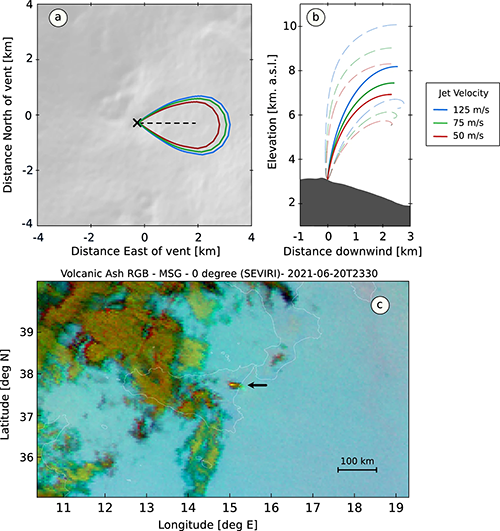Assessment of eruption source parameters using infrasound and plume modelling: a case study from the 2021 eruption of Mt. Etna, Italy

wavelengths) satellite image from the Spinning Enhanced Visible and InfraRed Imager (SEVIRI) at 23:30 on 20 June, 2021 (UTC time). The black arrow indicates the eruptive plume drifting towards the East. Panels (a) and (b) were generated by the PlumeRise model web interface (https://www.plumerise.bris.ac.uk). Panel (c) contains EUMETSAT Meteosat Volcanic Ash RGB—MSG—0 degree product derived from SEVIRI data. SEVIRI data were downloaded from the EUMETSAT data portal (https://view.eumetsat.int/productviewer?v=default). The map was produced with the Python packages Matplotlib v3.8 (https://matplotlib.org/) and GDAL v3.7.0 (https://gdal.org/index.html).
De Angelis S., L. Zuccarello, S. Scollo, L. Mereu, (2023).
Nature: Scientific Reports, 13. https://doi.org/10.1038/s41598-023-46160-6
Abstract
Atmospheric injection of volcanic ash during eruptions is a threat to aviation. Reliable forecast of airborne ash dispersal relies on empirical and numerical models. Key inputs into these models are so-called eruption source parameters such as the rate at which pyroclastic material is ejected from the vent and the maximum height of eruptive columns. Here, we use infrasound data recorded during eruptive activity in June 2021 at Mt. Etna, Italy, to demonstrate its potential for assessment of eruption rates in near-real time. We calculate a time series of flow velocity at the vent using data corrected for topographic scattering, and the effect of vent geometry on the acoustic source radiation. We obtain values of flow velocity of 50–125 m/s during a period of sustained, paroxysmal, activity. We use independent estimates from other ground-based remote sensing data to validate our results. Further, we use the infrasound-derived flow velocities as input into a 1D plume model to estimate the maximum height of the eruption column. Our results suggest that infrasound technology holds promise to assess eruption rates and inform modelling of volcanic plumes. We anticipate that implementation of real-time operational workflows based on infrasound data and plume modelling will impact decision-making and risk mitigation at active volcanoes.


Devi effettuare l'accesso per postare un commento.